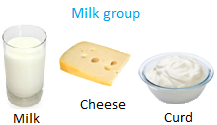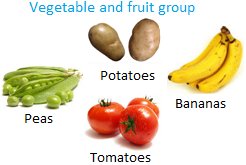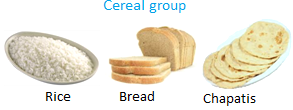Balanced Diet
We will discuss here about the balanced diet. The food that we eat everyday is our diet. Our diet must provide our body all the nutrients in proper quantities. Only then we will stay fit and healthy.
To remain fit and healthy, our diet should contain proper amount of proteins, fats, carbohydrates with enough quantity of water, mineral salts and vitamins.
A diet which contains all the nutrients in sufficient amount as required for proper functioning of the body, such a diet is called a balanced diet.
No single food contains all the nutrients in the right amounts. For a balance diet, therefore, we need to eat a variety of food daily. To make the selection of a balance diet easier, food items have been divided into the following four groups.
A balance diet should contain food items from each of these groups.
Protein group: Some
of the food items such as meat, eggs, fish, beans, nuts, peas, etc.
Milk group: Some of the food items such as milk, curd, cheese, etc.
Vegetable and fruit group: Fresh vegetables and fruits.
Cereal group: Some of the food items such as rice, bread, chapatti, noodles, etc.
A balance diet may vary for different kinds of persons, for example, sick person. Growing children need energy rich and protein rich diet, while sick persons need vitamins and mineral rich diet.
From Balanced Diet to HOME PAGE
Recent Articles
-
What Is Plasma? | Blood Plasma | Proteins | Nutrients | Cholesterol
Nov 07, 25 10:29 AM
Blood is a mobile fluid which is a connective tissue and is derived from the mesoderm like cell any other connective tissue. Colour of blood is reddish and that flows inside the blood vessels by means… -
Disorders of Respiratory System | Tuberculosis | Pleurisy | Emphysema
Oct 28, 25 11:39 PM
Tuberculosis is very common disease and is caused by a type of bacteria called Mycobacterium tuberculosis. This disease causes different trouble in the respiration and infection of several parts of th… -
Regulation of Respiration | Respiratory Centres | Inspiratory Area |
Oct 14, 25 12:13 AM
Respiratory Centre is the area that controls the rate of respiration and it is observed to be located in medulla oblongata and pons. Respiratory Centre has the following will dispersed components like… -
Explain Transport of Gases | External Respiration | Tissue Respiration
Oct 09, 25 11:35 PM
In humans gaseous exchange is completed in the following ways the steps are - External Respiration or Breathing - Breathing in false taking in of Oxygen and giving out of carbon dioxide in the body. M… -
Kind and Number of Teeth | Location of Teeth in Mouth | Care of Teeth
Sep 11, 25 12:52 AM
Kind and Number of Teeth









New! Comments
Have your say about what you just read! Leave me a comment in the box below.